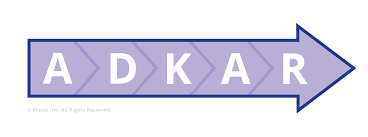Assertive Communication
Standing up for yourself in every situation is not always easy. Do you want to learn to really...
Implementing change processes within a company is known as one of the biggest challenges an organization can face. In this blog we will use the ADKAR model to positively influence changes.

Implementing change processes within a company is known as one of the biggest challenges an organization can face. Several studies have shown that not only the technical aspects and the organizational structure are important, but that the “Soft Lace” in other words, the employees, play an increasingly important role in achieving the desired goals.
Three factors are central here:
1. Ultimate use: how many employees embrace the new working method?
2. Competence: How competent are employees once the transition has been made?
3. Speed of adoption: how quickly do you involve your employees in the change process.
In this blog we will use the ADKAR model to positively influence these 3 factors.
It is important to use a structured approach to stimulate the human side of change as best as possible. The ADKAR model is a methodology from Prosci, it is mainly intended as a coaching instrument to help employees during the change process.
The model consists of five letters, these five letters represent the five steps you have to go through.

The first step in the change process is to become aware of the need for the change. As soon as you want to implement a change, it is important that you involve your employees directly and therefore indicate why change is necessary. If you indicate why it is necessary, they will be more likely to accept the change. If you do not do this, resistance may arise.
The second step is to create a desire to actually realize this change. A desire can arise from passion for the company, but the desire can also arise from personal gain. If you handle the change well, new career opportunities may arise, such as a new (higher) position, more respect from employees, respect from management or a salary increase.
Step three is gaining knowledge to realize the change. Lack of knowledge among employees is often a culprit. Precisely because it concerns a change, you cannot expect your employees to already have the knowledge to implement the change. It is therefore important that they first have enough knowledge. Ultimately, people must be able to convert knowledge into actions.
Competence is therefore also the fourth step and indicates whether people are capable of realizing the desired change. Some people have the competencies to realize the change and some do not. Help your employees to become competent, offer them courses or training so that they become competent and can realize the change.
As a final step, actions are also required to safeguard and further expand, or in other words, strengthen the change. This prevents employees from falling back into old habits. Therefore, continue to talk to people about (wrong) old habits or hold evaluation conversations to ask how things are going. This takes time, but is certainly appreciated. If employees see that you are doing everything you can to implement the change, they will do so too.
Do you want to apply change management immediately, but you don't know how? Or do you not know whether change management is suitable for you? We are happy to help you on your way Business Improvement.